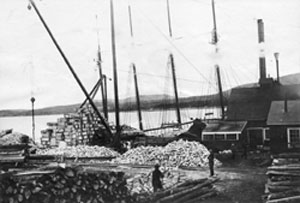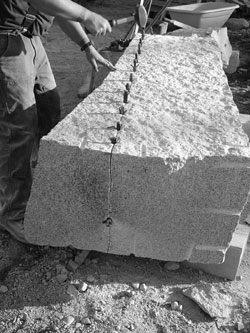
Quarries at Hall Quarry, Mount Desert Island lay on the only natural fiord on the eastern US seaboard. Deepwater frontage allowed ships to load at the lowest of tides. This stone has been carved to dimension, boxed at all edges to protect during shipping. Stones were also numbered to the architects specifications. Photo: The Maine Granite Industry Historical Society |
As city traffic increased in the early 1800’s, the streets, which were muddy, rutted by wagon wheels and thick with horse exhaust, were paved with cobblestones picked off the beaches. Boston was first to use cobblestones in the 1830’s, but they were smooth and slippery when wet. The cobblestone was replaced with cut granite paving blocks, commonly about 4"x8"x11", millions of them. These blocks were laid with the 8" dimension vertical.
By mid-century granite quarrying was becoming a big industry in Maine. The combination of the shipbuilding industry, accessible ports and an abundant supply of coastal granite made the state a major source of cut granite of all kinds. In 1889, Maine produced 17,704,915 paving blocks alone. In 1901 Maine was the nations number one granite producer. Hall Quarry alone, on MDI, shipped three million paving blocks annually.
Many a Maine hilltop was cut off for quarrying. As the demand for paving blocks increased, farmers would clear a hilltop of trees and begin cutting piles of paving blocks. Today, there are hundreds of abandoned quarries in Maine. Steve Haynes, granite worker, historian and operator of the Maine Granite Industry Historical Society Museum in Somesville, has visited and documented more than 350 abandoned quarries in Maine. One of the deepest, 100 feet, is in Hancock County. In Vermont, another granite state, but with considerably less coastline, the deepest quarry is in Barre; it bottoms out at 550 feet. Most abandoned quarries are filled with ground water. While they were worked, quarries had to be continuously pumped out. In the early days windmills provided the power for pumps.
The town of Sullivan, in Hancock County, was the principal source of many of the millions of paving blocks shipped from Maine. Daniel Sullivan started a quarry and built the first wharf to ship from Sullivan. Of the many areas of the Maine coast that supplied granite, the small town of Sullivan was one of the state’s largest suppliers. One of its quarries employed 150 men in the late 1880’s. By 1888 there were 375 men employed in the Sullivan quarries.
Sullivan is located on a good spot for granite quarrying, but an unusual location for transporting it. Ships were the only practical way to move the weight in the 19th century. Getting to Sullivan’s wharf below the quarries, that are up on what’s known as the “whalesback,” they had to sail over the narrow reversing tidal falls at the head of Frenchmen’s Bay and enter Taunton Bay. Enormous three-masted schooners came over the falls on an incoming tide, loaded tons of granite and then sailed out on a falling tide. Granite was also brought from distant locations in wagons to ports like Sullivan’s.

Cutting granite with half rounds and wedges in drilled holes at Sullivan Memorial Stoneworks in Sullivan, Maine. Tapping the wedges uniformly deeper, a little at a time, produces a changing ring until a crack forms along the row. A couple of more passes and the piece drops off. Photo: Fishermen's Voice |
In 1830, Sullivan’s first quarry cut blocks for buildings. In those days, an architect drew the plans, laying out the different rows of blocks with the sizes. The quarry cut from these plans. The stones were fitted with the neighboring or sister stone at the quarry, and then numbered, boxed and shipped. The building blocks were cut with mating services so accurately that only a minimum of mortar was used in the joints. If it was properly done, the blocks fit together so closely that no work was required at the building site; they were laid up like giant bricks
There were not a lot of measuring tools in the boom period and the work was done, for the most part, by eye. Quarrymen were paid well, and some made reputations for themselves. They earned respect by the number of paving blocks they could cut in a day, the accuracy of the large blocks they made or the complexity of the sculpted granite they worked.
Sullivan Memorial Stoneworks is one of just seven remaining commercial quarries in Maine. It is the only quarry still doing handwork using chisels and wedges. Gibran Buell operates the quarry. His route to stone cutting has been like that of his predecessors. He worked for years as an apprentice, cutting stone for all kinds of uses. Buell is familiar with the ancient means and tools of cutting granite. Many of the old tools are still used to split and shape pieces at Sullivan Stoneworks. He now cuts a lot of wharf blocks, mooring stones, curb and architectural granite.
Buell also has the modern tools that bore half-inch to three-inch diameter holes several feet deep in minutes. Enormous chunks, the size of small trucks, are split off. These are then cut to order. Buell makes the holes with a diamond tipped bit in a hand held compressed air powered drill. It creates a glass dust cloud as it pounds a one-inch hole four feet or more feet deep.
The drilling machine, a free standing compressed air powered drill, quickly cuts long rows of three-inch holes eight feet deep. But Buell also has the equipment used by his predecessors and knows how to use it. Drilling the holes with a pneumatic drill, he sets a pair of small half round sleeves that fit against the wall of the hole. The wedge fits between these half rounds, forcing the sides apart.
Drilling an eight-foot long row of holes recently, Buell set the half rounds and wedges. As he drove in the wedges, one after the other along the row, tightening them against the wall of the hole, the ring from the hammer blow changed tone with each pass. After several passes down the row a crack appeared. More hammer blows and the crack widened until a 12-inch wide, 24-inch deep and eight-foot long slab hit the ground with a 2,500-pound thud.
In the 1880’s, before power tools, electric or other, the blacksmith was the most important workman in the quarry. Granite was cut by hand with metal drill bits that are round chisels, unlike twist drills used on metal or wood. These round chisels, were powered by the blow from a heavy hammer in one hand and rotated by the other hand holding the bit. The process was to hit the end of the eight-inch long bit, rotate the bit a quarter turn and hit it again. Repeat a couple of dozen times and scoop the granite dustout of the hole with dust spoons. Repeat until the three quarter-inch diameter hole is three or four inches deep. After the third or fourth hole, the bit would go back to the blacksmith for sharpening. Holes were about six inches apart on a large slab. The blacksmith also tempered the tools and made a lot of the metal equipment used in the quarry.

The New York Custom House, NYC. 1907. Granite from several Penobscot Bay quarries was used in this building. The statues along the sidewalk and roofline were carved at Vinalhaven and Hurricane Island. Maine's congressional delegation helped boost the states large granite industry. Photo: Vinalhaven Historical Society |
Drilling with a hand bit was more like smashing a hole in the granite. The material, in spite of its weight, strength, durability, and hardness is a lot like glass. Buell said that two of the four basic particles granite is composed of are similar to glass. When a row of drilled holes is put under pressure from wedges driven into those holes, forcing two halves apart, the material eventually breaks. The break is similar to cut window glass.
Formed 340 million years ago, granite was laid out molten, in layers of varied thickness. Quarrymen drill a line of holes to the bottom of a layer and force the piece to snap off by driving wedges into those holes. In 1909, the largest piece of granite ever taken from a Maine quarry was cut at the Wharf Quarry on Vinalhaven. It was the only quarry where a piece large enough could be found. The layered granite there was thick enough and close enough to the surface that the 60-foot long, eight-foot square piece could be cut. It was later carved into a round column for the Church of Saint John the Divine in New York City. The granite Church of Saint John the Devine, built in the style of the European Medieval cathedral, has been under construction for over 100 years.
When the glaciers formed and piled up ice a mile deep, the weight of the ice put tension on and into the granite. Sometimes, when cutting, that tension is released. Buell said he has felt the cracking of granite under foot when cutting releases tension. He has also seen chunks of granite shot 12 feet in air by released tension.
As the industry evolved from producing foundation and wall blocks to ornamentation, Italian stonecutters were brought in to work in many coastal towns. Vinalhaven had several quarries where Italian stonecutters cut blocks, but they also carved eagles, gargoyles, and human figures to decorate granite buildings. Workers came from other parts of Northern Europe to work in Maine quarries. Marble quarries operated in Italy long before the 19th century granite boom in Maine.
Maine has a variety of granites, some highly prized. The famous pink granite is no longer allowed to be taken from Mount Desert Island. There are also gray and black granites. Later in the 1800’s, quarrying shifted to some islands where access to shipping was easy. On the 80-acre Dick Island, off Owls Head, the granite there was considered the finest in the world, according to Haynes. It is a salt and pepper color with fleks of pink. That operation there had 150 buildings, 2,000 men, and 52 team of oxen. Stonington was another major granite town. The islands in the harbor are still used, and the granite rubble lines the shores of Stonington’s many islands. One hundred years ago the winters were still cold enough that quarrymen walked to work on the Stonington Islands.
Some of the people who have been over a granite curb may have been in one of the famous American buildings built with Maine granite. Maine granite composes all or parts of the Washington Monument (DC); the Triborough, Williamsburg and Brooklyn Bridges (NY); several Naval Academy Buildings at Annapolis; the Cleveland, the Chicago and Boston Fine Art Museums; Grants Tomb; Sing Sing Prison; the Tombs (NY); and the John F. Kennedy Memorial (DC).
Steel and concrete construction replaced granite as a building material almost over night. The new materials made skyscrapers possible. With less labor, skill and transportation, steel and concrete were used in many of the other places granite had been. Demand for the stone dropped, quarries were abandoned and workers went on to the next booming business, or back to the farm. They left behind buildings that will probably last forever if they evade redevelopment plans. They also left behind some great swimming holes that will could outlast the buildings.
|





